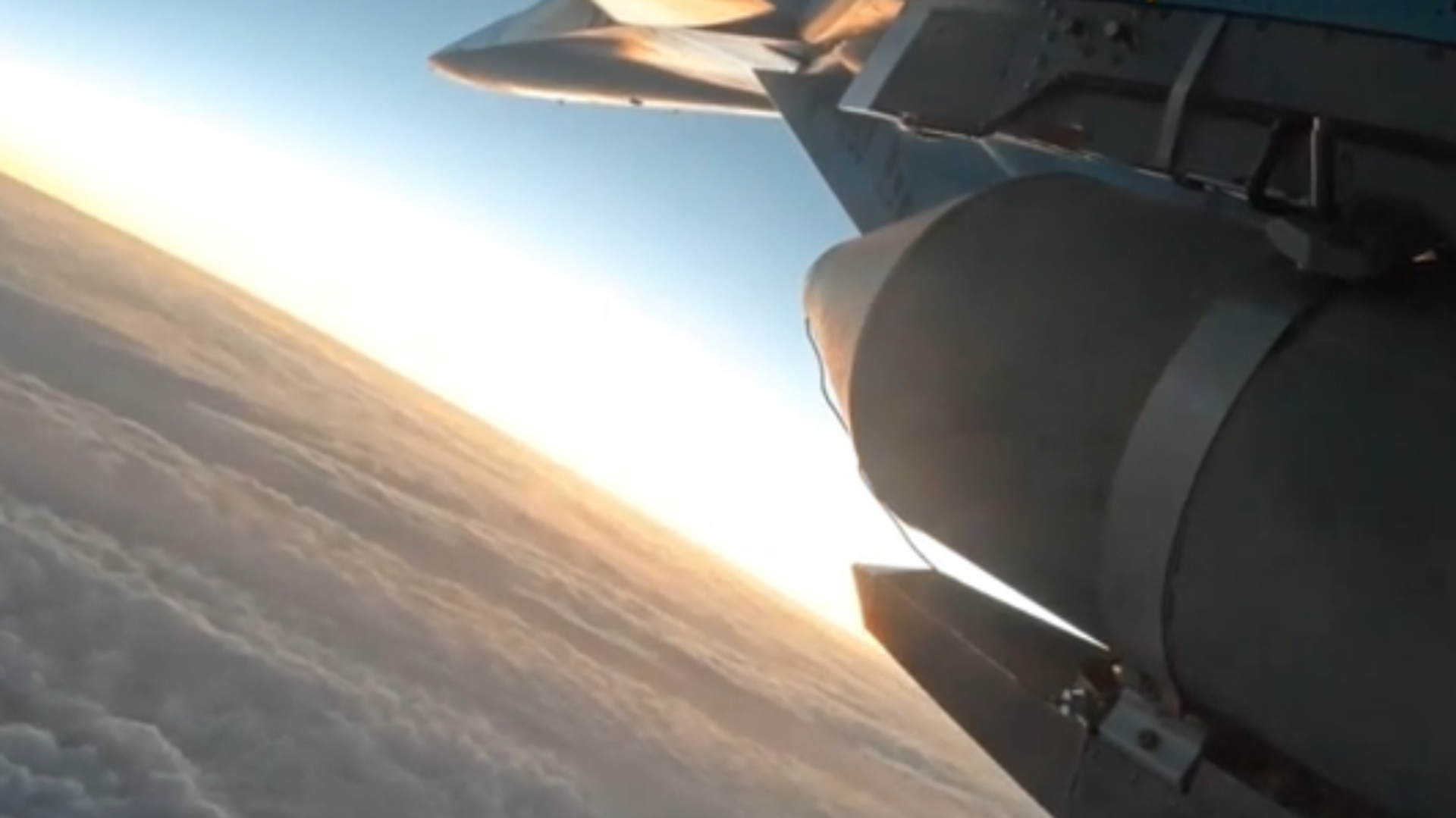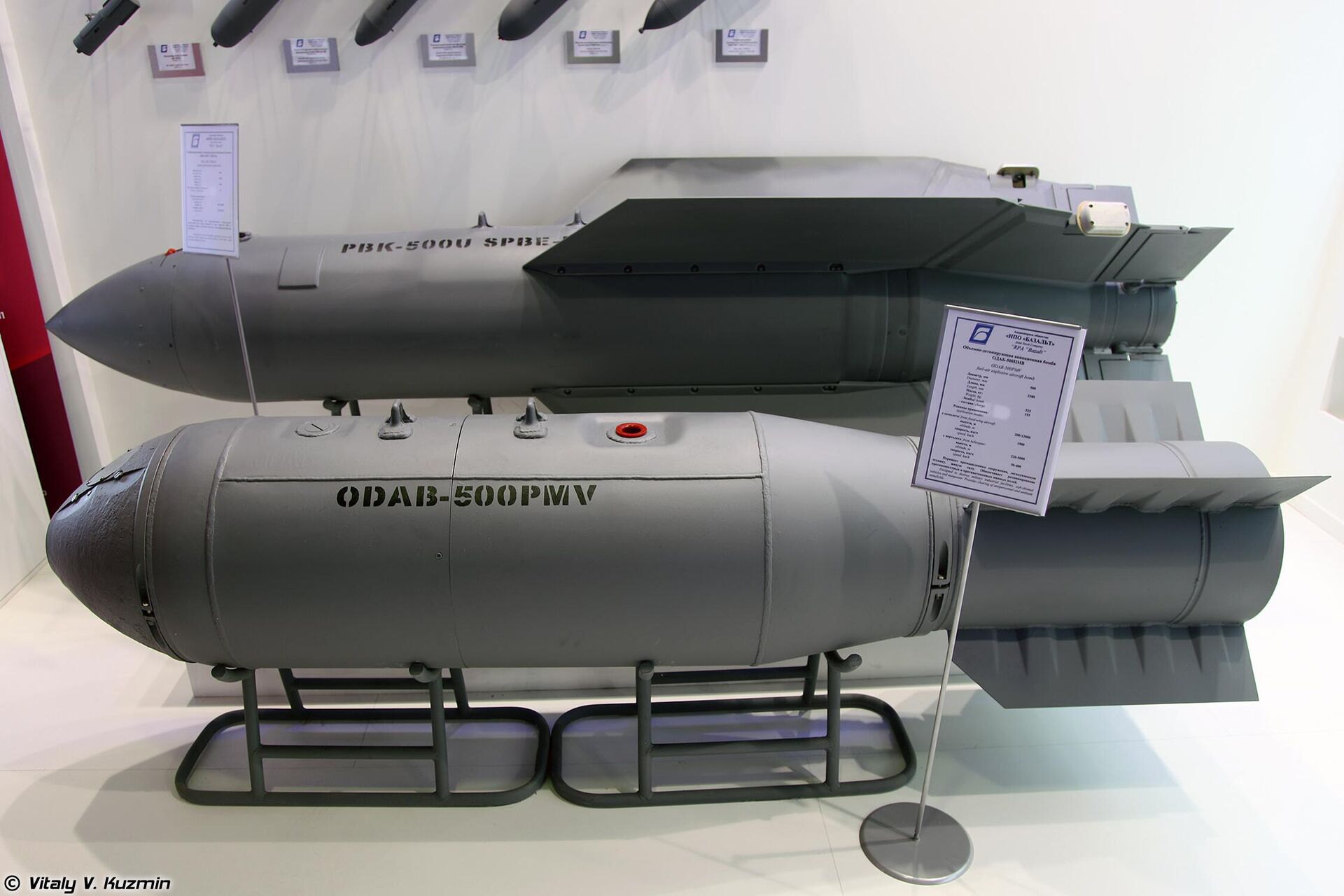https://sputnikglobe.com/20240404/odab-500-whats-known-about-russias-terrifying-air-dropped-vacuum-bomb-1117735790.html
ODAB-500: What’s Known About Russia’s Terrifying Air-Dropped Vacuum Bomb
ODAB-500: What’s Known About Russia’s Terrifying Air-Dropped Vacuum Bomb
Sputnik International
Russia’s Aerospace Forces have begun using some of some of their heaviest conventional firepower in recent weeks, striking Ukrainian entrenchments with FAB (Russian for ‘High-Explosive Aviation Bomb’) series munitions. Now, an even deadlier air-dropped weapon known as the ODAB-500 has been deployed. Here’s everything we know about it.
2024-04-04T14:44+0000
2024-04-04T14:44+0000
2024-04-04T16:08+0000
russia
ukraine
alexei leonkov
tnt
military
https://cdn1.img.sputnikglobe.com/img/07e8/04/04/1117736657_111:0:1306:672_1920x0_80_0_0_2f805a76ad36fd6f4dbc34907696734e.png
Russian Sukhoi Su-34 strike jets targeted Ukrainian positions in the Yuzhnodonetsk area of the front with ODAB-500 vacuum bombs this week, using ‘dumb’ thermobaric munitions upgraded into ‘smart’, guided, glide-assisted vacuum bombs using a new universal correction module.What are Vacuum Bombs?Air-dropped vacuum or thermobaric munitions operate along a two-stage principle: When dropped over the target area, they first eject an explosive liquid, creating a thick aerosol cloud. A fuse then triggers ignition at a pre-set time or elevation, with the aerosol mixture using oxygen in the area to fuel a powerful explosion, literally sucking up air from the surrounding environment.First thought up by Nazi Germany in the final months of World War II but never successfully used against Allied forces, the vacuum bomb principle was temporarily shelved before being returned to by American defense scientists in the 1950s. The US military actively used fuel-air explosive weapons in Vietnam in the 1960s and 1970s, devastating wide swathes of the country and neighboring Laos and Cambodia.When Was the ODAB-500 Created?The USSR followed up on these developments from the late 1960s onward, with the Moscow-based State Union Design Bureau Number 47 (now known as NPO Bazalt) developing the ODAB (Russian acronym standing for ‘Volumetric Detonating Aerial Bomb’) munition in the mid-1980s.The ODAB-500 was first used against the CIA-backed Mujahideen fighters in Afghanistan in the late 1980s, but deemed deficient due to technical limitations of the original model. A modified version known as the ODAB-500PM, equipped with a radio altimeter, was created and shown at an arms expo in Paris in 1995, with the ODAB-500PMV, further improved upon and optimized for deployment via helicopter, presented at a Russian arms expo in 2002.What are the ODAB-500's Characteristics?The ODAB-500PMV is 2.38 meters long, has a 0.5 meter diameter, and an operational envelope between 200 meters and 12 km. Su-34 strike jets can carry up to four of the thermobaric munitions each on external hard points.Thermobaric weapons like the ODAB consist of almost 100 percent liquid explosive mix. This results in a blast wave with a longer duration and makes the weapon more powerful in terms of TNT equivalent, especially in closed spaces like bunkers, tunnels, caves and other entrenchments. At the same time, their composition means that these weapons are not universal. Unlike TNT-based bombs, for example, they typically cannot be used underwater, at high altitudes or in highly adverse weather conditions.The ODAB-500 has damage radius of between 25 and 30 meters, and in addition to use against troops or entrenchments, can also be deployed to rapidly clear anti-tank minefields.Defense Ministry footage of ODAB-500s in action confirms the presence of the ‘Universal Planning and Correction Module’ – a new Russian conversion kit transforming unguided ‘dumb’ munitions into wing and rudder-equipped, laser and satellite-guided, glide-assisted weapons that can be fired from standoff ranges beyond those of enemy air defenses. The video showed small flashes emanating from the bombs after their release, with wings subsequently folding out, enabling the munitions to glide to their targets.These upgraded ODAB-500s are a force to be reckoned with, says Alexei Leonkov, a veteran Moscow-based military expert. In the event of their deployment, “everything on the surface is damaged. If living forces are present, they are destroyed.”In addition to the ODAB-500, which has a mass of between 520 and 525 kg, the ODAB series includes 1000, 1,100 and 1,500 kg variants of the weapon.
https://sputnikglobe.com/20240404/russian-su-34-frontline-bombers-hit-ukrainian-forces-with-odab-500-bombs-1117728780.html
russia
ukraine
Sputnik International
feedback@sputniknews.com
+74956456601
MIA „Rossiya Segodnya“
2024
News
en_EN
Sputnik International
feedback@sputniknews.com
+74956456601
MIA „Rossiya Segodnya“
Frontline Su-34 bombers attacked the Ukrainian military with ODAB-500 aerial bombs
Sputnik International
Frontline Su-34 bombers attacked the Ukrainian military with ODAB-500 aerial bombs
2024-04-04T14:44+0000
true
PT1M46S
Sputnik International
feedback@sputniknews.com
+74956456601
MIA „Rossiya Segodnya“
what is the odab-500, has russia used the odab-500
what is the odab-500, has russia used the odab-500
ODAB-500: What’s Known About Russia’s Terrifying Air-Dropped Vacuum Bomb
14:44 GMT 04.04.2024 (Updated: 16:08 GMT 04.04.2024) Russia’s Aerospace Forces have begun using some of some of their heaviest conventional firepower in recent weeks, striking Ukrainian entrenchments with FAB (Russian for ‘High-Explosive Aviation Bomb’) series munitions. Now, an even deadlier air-dropped weapon known as the ODAB-500 has been deployed. Here’s everything we know about it.
Russian Sukhoi Su-34 strike jets
targeted Ukrainian positions in the Yuzhnodonetsk area of the front with ODAB-500 vacuum bombs this week, using ‘dumb’ thermobaric munitions upgraded into ‘smart’, guided, glide-assisted vacuum bombs using a new universal correction module.
Air-dropped vacuum or thermobaric munitions operate along a two-stage principle: When dropped over the target area, they first eject an explosive liquid, creating a thick aerosol cloud. A fuse then triggers ignition at a pre-set time or elevation, with the aerosol mixture using oxygen in the area to fuel a powerful explosion, literally sucking up air from the surrounding environment.
First thought up by Nazi Germany in the final months of World War II but never successfully used against Allied forces, the vacuum bomb principle was temporarily shelved before being returned to by American defense scientists in the 1950s. The US military
actively used fuel-air explosive weapons in Vietnam in the 1960s and 1970s, devastating wide swathes of the country and neighboring Laos and Cambodia.
When Was the ODAB-500 Created?
The USSR followed up on these developments from the late 1960s onward, with the Moscow-based State Union Design Bureau Number 47 (now known as NPO Bazalt) developing the ODAB (Russian acronym standing for ‘Volumetric Detonating Aerial Bomb’) munition in the mid-1980s.
The ODAB-500 was first used against the CIA-backed Mujahideen fighters in Afghanistan in the late 1980s, but deemed deficient due to technical limitations of the original model. A modified version known as the ODAB-500PM, equipped with a radio altimeter, was created and shown at an arms expo in Paris in 1995, with the ODAB-500PMV, further improved upon and optimized for deployment via helicopter, presented at a Russian arms expo in 2002.
What are the ODAB-500's Characteristics?
The
ODAB-500PMV is 2.38 meters long, has a 0.5 meter diameter, and an operational envelope between 200 meters and 12 km. Su-34 strike jets can carry up to four of the thermobaric munitions each on external hard points.
The ODAB-500 is armed with 190-193 kg of volatile high-energy fuel-air explosive, exact recipe unknown. The use of this liquid slurry differentiates the ODAB design from most conventional explosives, which typically consist of a mixture of fuel and oxidizer (like gunpowder, which has a 25 percent fuel/75 percent oxidizer mix).
Thermobaric weapons like the ODAB consist of almost 100 percent liquid explosive mix. This results in a blast wave with a longer duration and makes the weapon more powerful in terms of TNT equivalent, especially in closed spaces like bunkers, tunnels, caves and other entrenchments. At the same time, their composition means that these weapons are not universal. Unlike TNT-based bombs, for example, they typically cannot be used underwater, at high altitudes or in highly adverse weather conditions.
The ODAB-500 has damage radius of between 25 and 30 meters, and in addition to use against troops or entrenchments, can also be deployed to rapidly clear anti-tank minefields.
Defense Ministry footage of ODAB-500s in action confirms the presence of the ‘Universal Planning and Correction Module’ – a new Russian conversion kit transforming unguided ‘dumb’ munitions into wing and rudder-equipped, laser and satellite-guided, glide-assisted weapons that can be fired from standoff ranges beyond those of enemy air defenses. The video showed small flashes emanating from the bombs after their release, with wings subsequently folding out, enabling the munitions to glide to their targets.
These upgraded ODAB-500s are a force to be reckoned with, says Alexei Leonkov, a veteran Moscow-based military expert. In the event of their deployment, “everything on the surface is damaged. If living forces are present, they are destroyed.”
“The ODAB-500 has a conical shape, allowing it to penetrate into certain hangers and create explosions there. Characteristics regarding how many meters of reinforced concrete a modern ODAB-500 can pierce are unknown. But here penetration occurs due to weight and initial force – that is, the speed which the ODAB gains when falling. And then, if it is blown up in an enclosed space, nothing living will remain inside. Equipment will be damaged, equipment will burn up, manpower will be killed,” the observer told Sputnik.
In addition to the ODAB-500, which has a mass of between 520 and 525 kg, the ODAB series includes 1000, 1,100 and 1,500 kg variants of the weapon.




